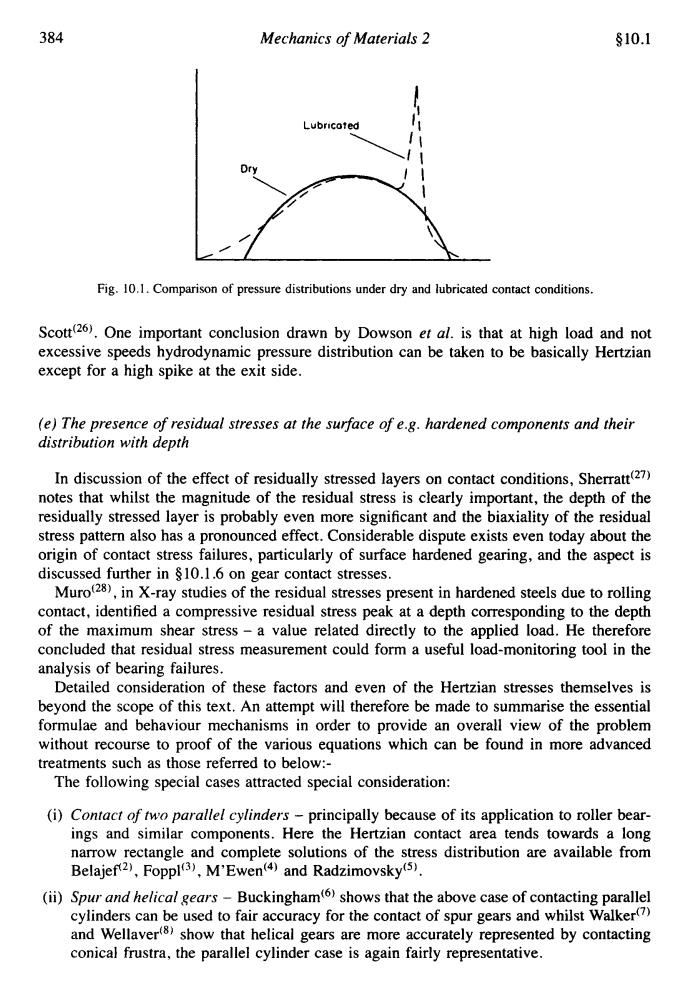正在加载图片...

384 Mechanics of Materials 2 §10.1 Lubricoted Dry Fig.10.1.Comparison of pressure distributions under dry and lubricated contact conditions. Scott(26).One important conclusion drawn by Dowson et al.is that at high load and not excessive speeds hydrodynamic pressure distribution can be taken to be basically Hertzian except for a high spike at the exit side. (e)The presence of residual stresses at the surface of e.g.hardened components and their distribution with depth In discussion of the effect of residually stressed layers on contact conditions,Sherratt(27) notes that whilst the magnitude of the residual stress is clearly important,the depth of the residually stressed layer is probably even more significant and the biaxiality of the residual stress pattern also has a pronounced effect.Considerable dispute exists even today about the origin of contact stress failures,particularly of surface hardened gearing,and the aspect is discussed further in $10.1.6 on gear contact stresses. Muro(28),in X-ray studies of the residual stresses present in hardened steels due to rolling contact,identified a compressive residual stress peak at a depth corresponding to the depth of the maximum shear stress-a value related directly to the applied load.He therefore concluded that residual stress measurement could form a useful load-monitoring tool in the analysis of bearing failures. Detailed consideration of these factors and even of the Hertzian stresses themselves is beyond the scope of this text.An attempt will therefore be made to summarise the essential formulae and behaviour mechanisms in order to provide an overall view of the problem without recourse to proof of the various equations which can be found in more advanced treatments such as those referred to below:- The following special cases attracted special consideration: (i)Contact of two parallel cylinders-principally because of its application to roller bear- ings and similar components.Here the Hertzian contact area tends towards a long narrow rectangle and complete solutions of the stress distribution are available from Belajef2),Foppl(3),M'Ewen(4)and Radzimovsky(5). (ii)Spur and helical gears-Buckingham(6)shows that the above case of contacting parallel cylinders can be used to fair accuracy for the contact of spur gears and whilst Walker(7) and Wellaver(8)show that helical gears are more accurately represented by contacting conical frustra,the parallel cylinder case is again fairly representative.384 Mechanics of Materials 2 $10.1 Fig. 10.1. Comparison of pressure distributions under dry and lubricated contact conditions. Scott(26). One important conclusion drawn by Dowson et al. is that at high load and not excessive speeds hydrodynamic pressure distribution can be taken to be basically Hertzian except for a high spike at the exit side. (e) The presence of residual stresses at the surface of e.g. hardened components and their distribution with depth In discussion of the effect of residually stressed layers on contact conditions, She~~att(~~) notes that whilst the magnitude of the residual stress is clearly important, the depth of the residually stressed layer is probably even more significant and the biaxiality of the residual stress pattern also has a pronounced effect. Considerable dispute exists even today about the origin of contact stress failures, particularly of surface hardened gearing, and the aspect is discussed further in $10.1.6 on gear contact stresses. Muro(28), in X-ray studies of the residual stresses present in hardened steels due to rolling contact, identified a compressive residual stress peak at a depth corresponding to the depth of the maximum shear stress - a value related directly to the applied load. He therefore concluded that residual stress measurement could form a useful load-monitoring tool in the analysis of bearing failures. Detailed consideration of these factors and even of the Hertzian stresses themselves is beyond the scope of this text. An attempt will therefore be made to summarise the essential formulae and behaviour mechanisms in order to provide an overall view of the problem without recourse to proof of the various equations which can be found in more advanced treatments such as those referred to below:- The following special cases attracted special consideration: (i) Contact of tw~o parallel cylinders - principally because of its application to roller bearings and similar components. Here the Hertzian contact area tends towards a long narrow rectangle and complete solutions of the stress distribution are available from BelajeP2), F~ppl'~), M'Ewed4) and Radzimov~ky'~). (ii) Spur and helical gears - Buckingham(6) shows that the above case of contacting parallel cylinders can be used to fair accuracy for the contact of spur gears and whilst Walker(') and Wellaver@) show that helical gears are more accurately represented by contacting conical frustra, the parallel cylinder case is again fairly representative